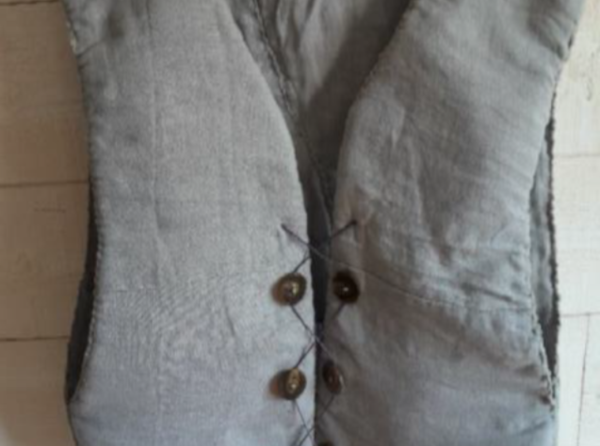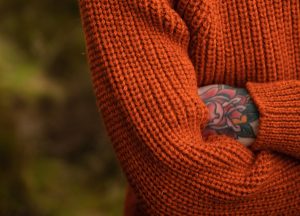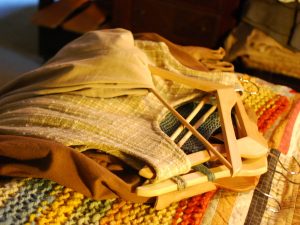Doing agricultural or building work in an ever-hotter world will become more and more difficult and dangerous in future. Evaporative cooling vests exist to help people stay cool and safe whilst doing heavy, hot work. Here, Geoffroy Levy describes his ideas for a DIY evaporative vest made from natural materials.
It can also be used indoors, removing the need for expensive and environmentally-damaging aircon.
Introduction
While dealing with the increase in the frequency and intensity of heat waves, especially in previously less exposed areas, the common habits and necessary skills to cope with high temperatures are generally absent or poorly adapted.
The health risks and discomfort associated with repeated exposure to high temperatures (>25°C) led me to imagine a nomadic accessory that would allow me to feel better while getting through these hard times.
When it is possible to have a cool, ventilated place, managing body temperature in this welcoming space is relatively simple. The problem becomes more complex when someone’s activity (induced or voluntary) does not allow him or her to benefit from a cool environment. A construction site, an agricultural activity, a hike or crossing a city are risky situations during which it is necessary to give the priority to the cooling of the body instead of cooling of the living space.
With the dream of having a thermal suit similar to the stillsuits in Frank Herbert’s Dune saga and inspired by the cooling vests available as personal protective equipment on the market, I designed this accessory as a daily tool that can be made by everyone from natural and/or local materials.
Let us imagine getting into the habit of putting on the cooling vest as one would take, by reflex, a pair of sunglasses or an umbrella.
Principle and materials
Evaporation, the key for cooling:
Like the desert fridge in which evaporation of the water contained in the sand through the terracotta reduces the temperature of the storage chamber, I looked for a range of flexible and light materials that perform the same function.
My research led me to combine flax and hemp fibers for their absorbent and antibacterial properties.
The objective is to maximize water evaporation to create real cooling while maintaining a good autonomy (before refilling the accessory with water) and avoiding bad odors and health risks.
The temperature drop is gradual but rapid from the temperature of the water used to a stabilization of the cooling effect within 5 minutes after the soaking. It evolves with the surrounding airflow and the water reserve contained in the absorbent fibers.
Flax and hemp together provide the solution:
- Woven linen can be used to make the structures of the accessory such as a garment or a hat.
- Hemp in the form of non-woven felt with a thickness of about 5mm serves as a water reservoir.
| Materials | Description | Quantity Used / Accessory | Cost / Accessory (Prototype) |
| Flax | Pure linen fabric – origin: second-hand clothing | Approx. 1 m2 | ~ 3 € |
| Waxed cotton | Waxed cotton with beeswax (bought already coated) | Approx. 0.5 m2 | ~ 10 € |
| Hemp felt – mulching in rolls | Natural hemp felt – grown in France – 2 x 0.5 m – 600 gr/m2 | Approx. 0.5 m2 | ~ 7 € |
| Pimples | Large plastic buttons | From used clothing | 0 € |
| Thread and lace | Sewing thread and lace for closure | Stock | 0 € |
Architecture
The accessory (whatever its shape) can be made in two versions: dry or wet.
Hemp felt is placed between two layers of natural fiber fabric.
The inner layer of fabric (in contact with the wearer) differs between the two versions.
The choice between the two versions is free depending on the desired effect, the context and the provisioning.
Dry version:

The dry version requires a waterproof layer between the wearer and the accessory so as not to excessively wet the wearer’s clothes or skin.
To keep the natural look of the materials used, I chose a cotton waxed with beeswax (bought already coated).
Hemp felt is placed between a layer of linen and a layer of coated cotton (coating towards hemp).
The three layers work together to create a cooler surface in contact with the wearer’s skin while remaining low in moisture (with no visible wet halo). This allows the accessory to be worn without having to change clothes when you take it off.
Wet version:

The wet version is simpler. It does not require a waterproof layer between the wearer and the accessory.
The hemp felt is placed between two layers of linen.
The three layers work together to create a cooler, moister surface on contact with the wearer’s skin.
For comparable cooling, the feeling of freshness is more intense but leaves the wearer’s clothes wet.
Accessory type and patterns
The accessory presented is a short vest worn close to the body for optimal contact with the wearer.
I designed it as simple as possible to make it easier to integrate into common clothing styles. It is an operational prototype without any particular stylistic research. Its architecture is compatible with many styles.
The total thickness of the three layers is compatible with either hand or machine sewing. As long as the three-layer principle is respected, the form is completely free. This accessory has been designed as one of the elements of a triptych adapted to areas with high vascularization or heat sensitivity:
- Vest or chasuble to cool the upper body.
- Cap with flaps (for the ears) to cool the head.

- Neck piece to cool the neck and shoulders.
Sewing can be done in two different ways:
- In panels (like the prototype), where the felt serves as a support for the two layers of fabric sewn on either side.
- In turned-over pockets, where the felt is inserted into a pocket formed by the two layers of fabric sewn front sides together and then turned over to hide the seams.
Tutorial (sewing in turned pockets)
- Make the pattern using a garment fitted to the wearer (for better contact with the skin) by tracing the contours of the back on a sheet of paper and adding 15 mm for the seam along the entire line.
- Draw a vertical line in the center of the pattern and trace the neck cutout (round or V-shaped) and the arm passages by adding the 15 mm on the outside of the collar and the arm passage and on either side of the vertical line.
- Cut out the pattern and transfer the back and front lines including the seam lines (15mm inside) to the fabric.
- Cut the pieces in sufficient number and according to the dry or wet version (2 x for the wet version and 1 x per type of fabric for the dry version).
- Sew the pieces front sides together, leaving an unsewn part to pass the felt.
- Turn the pockets over.
- Use the pockets to trace the contours of the cut on the felt.
- Cut the felt pieces into one copy inside the cutting lines.
- Insert the felt pieces into the crease-free pockets using a rigid stick.
- Hand sew the remaining openings on the pockets.
- Assemble the vest, making sure to place the pieces front side together.
- Sew at the shoulders and sides.
- Turn the vest over.
- Add the closure of your choice on the front (eyelets, buttons, Velcro…).




How to use it
- Place the vest flat on a surface.
- Fill a container with about 0.5 litre of clean water.
- Lightly pour in the outer surfaces (front and back).
- Press the surfaces with the flat of your hand to evenly soak the felt.
- Put on the vest, making sure that it fits well on the wearer. The effect is fast.
Possible variants
The specifications drawn up for this operational prototype include the desire to design a simple and sustainable solution from natural materials.
Depending on the situation, supplies and production methods, it is quite possible to make a cooling accessory from synthetic materials whose performance remains to be tested and validated. These alternatives would make it possible to distribute the solution in an environment where a resource can be difficult to find.
| Prototype materials | Example of a possible variant (not tested) |
| Flax | Polyester micro-mesh |
| Waxed cotton | Coated waterproof fabric |
| Hemp felt | Microfiber towel |
Test Results
This vest has been tested in different situations and versions (measurements made with glass alcohol thermometers and electronic probe (for cooking) in contact with surfaces).
Beyond the actual drop in temperature on the surface of the skin, wearing this vest creates a feeling of protection behind a heat shield. In addition to cooling solutions for the head and neck, it has prevented headaches and severe fatigue associated with prolonged exposure to heat despite good hydration in several cases.

You can contact Geoffroy here.





